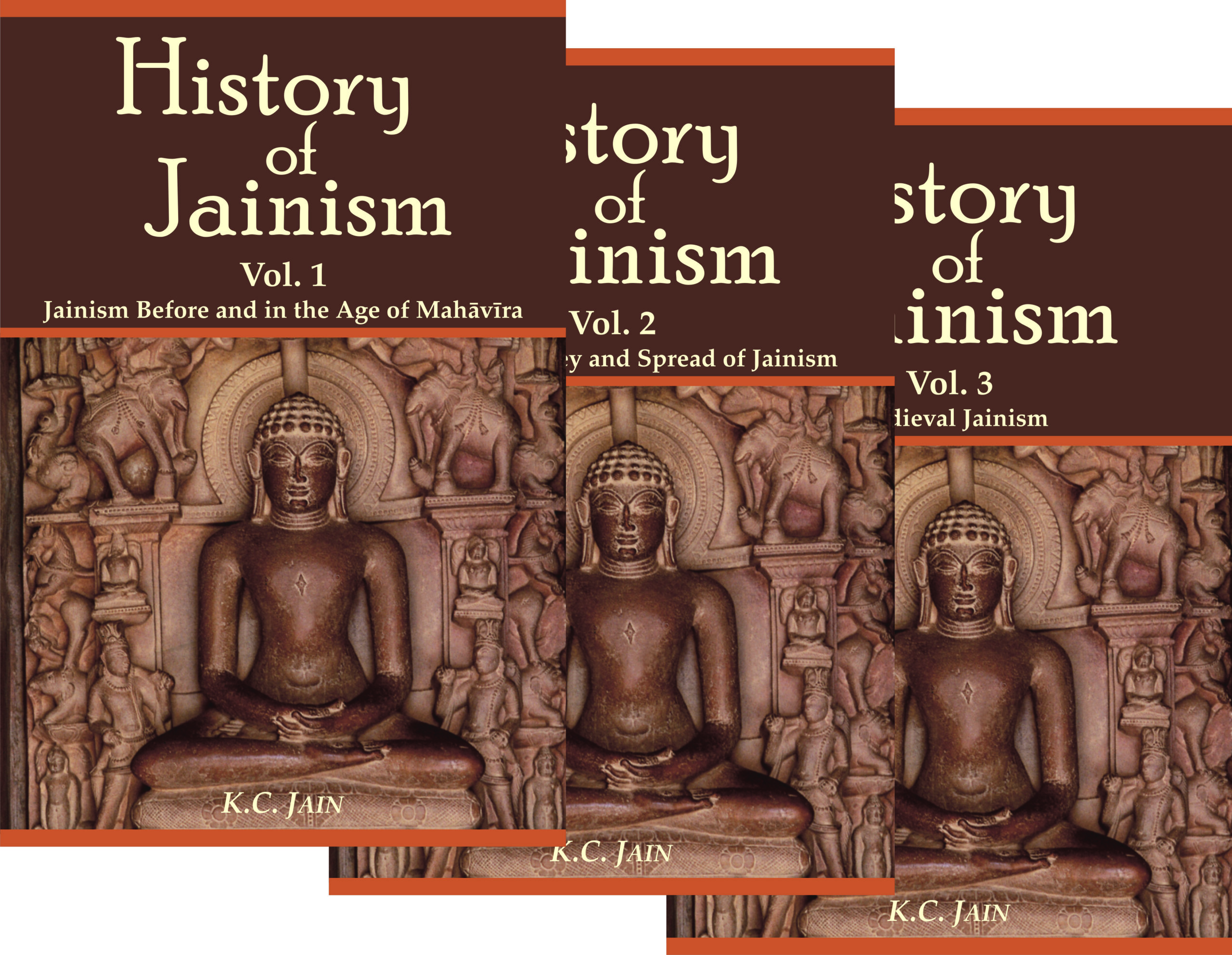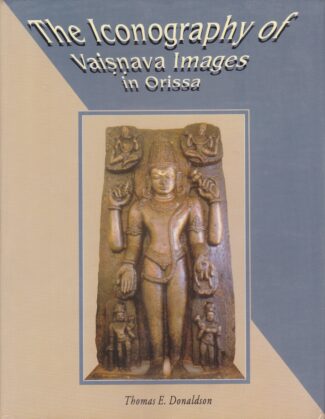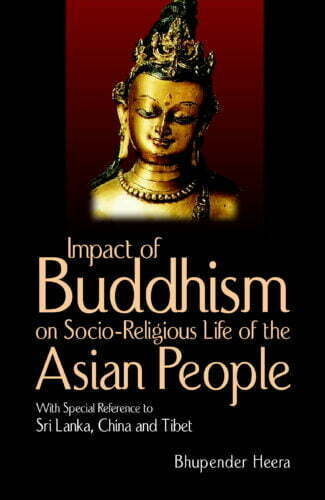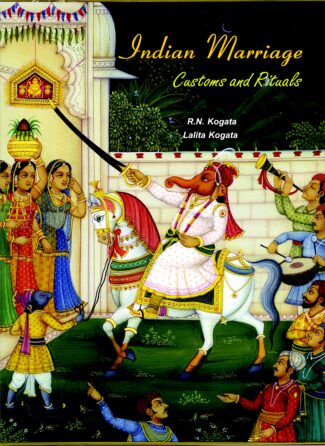Showing 85–96 of 247 results

This book, presented in three parts, surveys the history of the Jaina dharma, its expansion under the Mauryas and Kharawelas, its nourishment by Cauhana, Paramara, Calukya, Rastrakuta and Ganga Kingdoms, its profound influence on life in India, particularly during the middle ages, and its survival during the Muslim rule.
History of Jainism has been presented here in three parts. The first part tries to prove through the archaeological and literary sources the historicity of Tirthankara, Parshvanatha and Mahavira, explaining their life and education besides religious, political, social, artistic and literary conditions of their times.
The second part surveys the history of the Jaina dharma, its expansion and significance. The effects of Jaina dharma increased when Mauryas were ruling Magadha and Kharawelas ruled Orissa. No doubt, the period from the ninth to twelfth centuries ce was a golden time in the history of Jainism and even traders, labourers and craftsmen were highly influenced by it during Kushana period. Seen geographically, Cauhana, Paramara and Calukya were acting as watchmen for Jainism in the north, and in the south it was being nourished by Rashtrakuta and Ganga (Kingdoms). Many Jaina temples were constructed, and monuments erected in honour of their deities. This part illustrates the many ways in which Jainism was served by the Jaina monks, saints, scholars and the politicians and answers questions such as: What kind of religious and social unions were made after the division and what were their traditional characteristics? How were the different leagues and monasteries of Jaina sages made? What was the lineage of various castes and how it originated?
The third part, associated with the middle ages of Jainism, describes that even though there was Muslim rule, still many organizations were sponsored with the influence of Jainism. Truthfully, there was a decline in Jainism during the middle ages but it remained protected. Many pilgrimages and historical places were established with the great influence of Jainism. Dr A.H. Nizami has written here about the Muslim reign, conditions of Jainism and also about the admirable Jainas. Dr Surendra Gopal has described the social and financial conditions prevailing during this period. Dr Shyam Sunder Nigam has penned on the Middle Ages of India and Dr Prakash Chandra Jain has written about the Jaina religion in the Middle Ages in Malwa region.
This monumental work will be a treat for the minds and eyes of people curious about Jainism.

This volume Hymns to the Goddess is an endeavour of Sir John Woodroffe (Arthur Avalon) to translate the Sanskrit hymns in praise of the Goddess or Devi, scattered in Tantra and Purana texts, Mahabharata, and in the hymns of Shankaracharya. Hymn to Kali (Karpuradi Stotra), another book within the book, is a celebrated Kaula stotra, having commentary on the hymns.
The Goddess or Devi is God in Its Mother aspect. Devi, who is existence, consciousness and bliss, is thought of as a female, a male or pure Brahman. This volume Hymns to the Goddess is an endeavour of Sir John Woodroffe (Arthur Avalon) to translate the Sanskrit hymns in praise of the Goddess or Devi, scattered in Tantra and Purana texts, Mahabharata, and in the hymns of Shankaracharya, who was an incarnation of devotion and a great philosopher, Valmiki and Indra.
After a general introduction, the book starts with a hymn to Kalabhairava, the spouse of Devi, followed by Devi stotras. In these hymns, Devi is praised as Bhairavi, Bhuvaneshvari, Adyakali, Lakshmi, Tara, Mahishamardini, Annapurna, Sarasvati, Durga, Tripura in Tantra texts; Sarvavishvajanani, Ambika, Chandika, Mahadevi and Jagadambika in Puranas; Durga, Arya, Durga in Mahabharata; Tripurasundari, Ganga, Ananadalahari, Yamuna, Narmada and Mahalakshmi.
Hymn to Kali (Karpuradi Stotra), another book within the book, is a celebrated Kaula stotra, having commentary on the hymns. It, in addition to mantroddharadhara, contains stotras of dhyana, yantra, sadhana, madya, mamsa, maithuna and phala-shruti matters.

This volume Hymns to the Goddess is an endeavour of Sir John Woodroffe (Arthur Avalon) to translate the Sanskrit hymns in praise of the Goddess or Devi, scattered in Tantra and Purana texts, Mahabharata, and in the hymns of Shankaracharya. Hymn to Kali (Karpuradi Stotra), another book within the book, is a celebrated Kaula stotra, having commentary on the hymns.
The Goddess or Devi is God in Its Mother aspect. Devi, who is existence, consciousness and bliss, is thought of as a female, a male or pure Brahman. This volume Hymns to the Goddess is an endeavour of Sir John Woodroffe (Arthur Avalon) to translate the Sanskrit hymns in praise of the Goddess or Devi, scattered in Tantra and Purana texts, Mahabharata, and in the hymns of Shankaracharya, who was an incarnation of devotion and a great philosopher, Valmiki and Indra.
After a general introduction, the book starts with a hymn to Kalabhairava, the spouse of Devi, followed by Devi stotras. In these hymns, Devi is praised as Bhairavi, Bhuvaneshvari, Adyakali, Lakshmi, Tara, Mahishamardini, Annapurna, Sarasvati, Durga, Tripura in Tantra texts; Sarvavishvajanani, Ambika, Chandika, Mahadevi and Jagadambika in Puranas; Durga, Arya, Durga in Mahabharata; Tripurasundari, Ganga, Ananadalahari, Yamuna, Narmada and Mahalakshmi.
Hymn to Kali (Karpuradi Stotra), another book within the book, is a celebrated Kaula stotra, having commentary on the hymns. It, in addition to mantroddharadhara, contains stotras of dhyana, yantra, sadhana, madya, mamsa, maithuna and phala-shruti matters.

This work analyses the Vaisnava iconography of Orissa. Vaisnava iconography proper including Hari-Hara and other composite images and those of Visnus female consorts; images of Visnu in his avataras; depiction of Balarama, Krsna and Jagannatha; and iconography of the secondary figures like Garuda and Hanumana.
This work is a well?researched attempt to analyse the Vaishnava iconography of Orissa which is unique in that there are to be found an overwhelming number of Vishnu images in the region despite paucity of Vishnu temples and inscriptional evidence suggesting royal patronage. Dr. Donaldson here undertakes a detailed study under four heads: Vaishnava iconography proper including Hari?Hara and other composite images and those of Vishnus female consorts; images of Vishnu in his different avataras; depiction of Balarama, Krishna and Jagannatha; and iconography of what are termed secondary figures like Garuda and Hanumana. He presents various iconographic charts throughout the book on the basis of textual description of the many images and their representations in sculpture with a number of photographs of the images studied, he provides details on the physical attributes of each group of images and specific images and their evolving iconographic and stylistic peculiarities: such as the decline of a particular motif and the emergence of another depending on the popularity of sects. The author also traces with keen interest the influence of Vaishnavism on the iconographic programme and rituals of Shaiva temples, resulting in even joint worship of Vishnu and Shiva. For each type of iconography, the book cites examples of different Orissan temples and discusses the images in them. The book would be of immense interest to scholars of religious studies and particularly those concerned with Hindu iconography.

The book analyses the social and cultural transformation of the people of Asia, particularly in Sri Lanka, China and Tibet brought about by Buddhist monks, missionaries and royal personages in a matter of centuries.
Buddhism is an ancient religion that spread across Asia in a matter of centuries and had a rare kind of influence on the social and religious life of the Asian peoples. The volume stresses on the social and cultural transformation brought about by Buddhism when the royalty in these countries adopted the religion and propagated it. It deals with Sri Lanka’s evolution into a stronghold of Theravàda Buddhism and China and Tibet’s contribution to the Mahàyàna and Tantrayàna Buddhist traditions. It takes up the royal patronage and zeal of missionaries, Buddhist influence on the social structure and personal names, impact of Buddhism on customs, lifestyle, food habits and spread of education and learning in Sri Lanka. It covers factors that encouraged spread of Buddhism in China, architectural and art works undertaken there, and the flourishing of Buddhist literature and missionary work under royal patronage in that country. The work captures the effect of Buddhism on Tibetan religious thinking and social life. It also discusses the later socio-cultural transformation of people of nearby countries owing to the missionary zeal of Buddhism in those countries. Throughout, the work refers to numerous legends and accounts for detailing the contribution of monks, missionaries and royal personages. The book will prove immensely valuable to Buddhist scholars keen on studying the evolution and impact of Buddhism in Asia.
The South-East is a cultural perspective aptly named agneyi the direction of the God Agni. It is reflected even in the Sino-Japanese Mahakarunagarbha mandala of the 8th century where Agni is surrounded by sages: Angiras with his consort Gautami and Atreya with his consort Bhrgvi. In the Pao-hsiang Lou pantheon Agni is surrounded by eight rsi’s Angiras, Vasistha, Garga, Markandeya, Gautama, Kasyapa, Shan-ch’eng-ming-yang and Su-chi-i (the Sanskrit names of the last two have to yet to be found). In Indic terms, the conceptual space of SE Asia endows it with the serenity of the mind, the grandeur of structures, the profundity of expression derived from Sanskrit. The SE is the mind ground of the sages, the rishis, and as such the marvellous manifestation of the Hindu-Buddhist genius. This book chronicles the dynamism, the fire, the Agni of the Agneya (SE) direction across the past that shades into the present with tomorrows inside.
Can Indian civilization be compared to a “thousand-branched tree”? What have been its outstanding achievements and its impact on the world?
These are some of the questions this book asks. But it also deals with issues confronting more and more Indians caught in an identity crisis: What does it mean to be Indian? What is specific to the worldview developed by Indian culture? How has it dialogued with other cultures? Is it built on durable foundations, or is it little more than colourful religiosity and quaint but outdated customs? And what are the meaning and application of secularism and tolerance in the Indian context?
The French-born author, who has been living in India for 33 years, argues that Indian culture is not some exotic relic of the past, but a dynamic force that still has a role to play in defining India’s identity and cohesion, and in proposing solutions to today’s global challenges.
Written in a crisp and engaging style, this thought-provoking volume challenges received ideas on India’s culture and invites us to think afresh.
Can Indian civilization be compared to a “thousand-branched tree”? What have been its outstanding achievements and its impact on the world?
These are some of the questions this book asks. But it also deals with issues confronting more and more Indians caught in an identity crisis: What does it mean to be Indian? What is specific to the worldview developed by Indian culture? How has it dialogued with other cultures? Is it built on durable foundations, or is it little more than colourful religiosity and quaint but outdated customs? And what are the meaning and application of secularism and tolerance in the Indian context?
The French-born author, who has been living in India for 33 years, argues that Indian culture is not some exotic relic of the past, but a dynamic force that still has a role to play in defining India’s identity and cohesion, and in proposing solutions to today’s global challenges.
Written in a crisp and engaging style, this thought-provoking volume challenges received ideas on India’s culture and invites us to think afresh.

Marriage or Vivaah, particularly in India, is a sacred ceremony comprising various customs Þ religious and social Þ and Vedic rituals. These are meant to propitiate the gods for obtaining their blessings for the bride and the bridegroom, and to honour and entertain those who participate in the celebrations. This book explains in detail, all the important rituals which form part of the marriage.
Marriage is considered a very significant ritual for giving societys sanction to a close relationship between a man and a woman as husband and wife. It is, therefore, also called a social system. The marriage ceremony is a combination of many rituals, based on information contained in Hindu scriptures. It also represents and reflects the social customs and practices that are prevalent in the society. The rituals vary depending upon the community, the religion and the state where they are performed. The marriage customs, rites and rituals among royal families are mentioned in this book most of these rituals are followed by common people as well and are performed in the original or altered forms in the Indian society. Mr R.N. Kogata and Mrs Lalita Kogata did a lot of research and consulted several authorities and have written in detail about the various rituals involved in a human beings life from birth to death. Different scholars have mentioned different numbers of rituals and sacraments 25, 40 or 48. But Maharishi Veda Vyasa has described 16 rituals as important. Out of these, the Vivaah (marriage) samskaar itself encompasses various rituals the main ones covered in this book are: the Bindaulee (wedding procession); Hathalevaa (hand-taking ceremony or paanigrahan), Phere (agni pradakshinaa, circumambulation of fire); Kanyaadaan (giving away daughter in marriage); Maangbharaaye (filling vermilion); Mangalsutra (tying the wedding thread); Saptapadee (walking seven steps together); and Vadhu kee Vidaaee (brides departure to her in-laws house). This book should be in all households in order that all will know the meanings of the various rituals in a marriage particularly in the present days when learned pandits who can explain the rituals, are few, and people have no time or inclination to go through voluminous scriptures or texts on the subject of marriage.
Does Indian civilization have the capacity to change or has it been static? The impression of this civilization as an unchanging one has been revised today. Conflict-tension processes in a complex heterogeneous civilization like that of India are equally important and require in-depth studies along with investigating the continuity of tradition. It is in this context that protest, dissent and reform movements have also played a critical role and facilitated adjustments to changing social realities over the centuries. From time to time alternate systems to the accepted ideological or normative patterns have been suggested. Apparently many of these movements were religious in nature, but the socio-economic context which remains in the background does require further detailed examination. The present volume reflects some aspects of these movements. It is one in the series undertaken as part of the group project A Sourcebook of Indian and Asian Civilizations at the Indian Institute of Advanced Study. The essays in this volume by such scholars as Arun Bali, Savitri Chandra, Narendra Mohan, M.G.S. Narayanan and Veluthat Kesavan; Y.M. Pathan, M.S.A. Rao, Sachchidananda, G.B. Sardar and Pushpa Suri will stimulate discussion and generate new perspectives towards understanding Indian civilization.

This volume is collection of eight lectures delivered by Dr Kapila Vatsyayan on different occasions, some in the memory of four eminent persons and another four on critical issues related to culture.
This volume is collection of eight lectures delivered by Dr Kapila Vatsyayan on different occasions, some in the memory of four eminent persons such as Ancharlott Eschmann, an art historian; Dr C.D. Deshmukh, founder of the India International Centre and former Chairman, University Grants Commission; Prof. Birendra Kumar Bhattacharyya, eminent writer social worker andformer president of the Sahitya Akademi and Dr D.S. Kothari, the doyen of science and a dedicated Gandhian, and the remaining four on a few critical issues related to culture.
These lectures delve upon crucial terms and topics like shastra and prayoga, and marga and desi in the study of Indian arts, other social systems and the sociology of religion; interface of culture and development; role of arts in social transformation; a modern rishi, the eco-cultural cartography of South Asia; the oral and written systems of knowledge transmission; the different aspects of Indias cultural heritage and identity; and Hinduism as a religion of divine immanence, where concepts like purusharthas and varnashrama-dharma are all part and parcel of the all-encompassing Sanatana Dharma.
This book thus enables readers to enlarge and nurture Indias cultural heritage and its allied features. In a fast-changing world, one should know his cultural past and thereby prepare himself to absorb what is needed, without losing his identity and existence.

The book deals with evolution of Mughal architecture (ad 1526 to 1658) and explains the distinct characteristics of Mughal art the use of architectural material by the Mughals, their roofing techniques, their dome and the special features of the Mughal jharokha. Prof. Nath delves into the concepts and customs the Mughal architecture involved, discussing examples of monuments in detail.
It deals, extremely briefly, with the evolutionary process of Mughal Architecture, practically from Babur to Shah Jehan (1526 to 1658 ad). Instead of being an exotic phenomenon, as it is largely misunderstood, Mughal Architecture, like the Gupta art, was deeply rooted in the soil and it grew and developed not only on indigenous forms and techniques, but also on its concepts, customs and beliefs. It was owing to the decisive participation of native sources, in its development, that such a wonderful monument as the Taj Mahal could be built in India, and nowhere else. The Land, the People and the Culture have made it what it is, which is why it is so diametrically different from any other art of Islam. Written in a simple language, without the research jargon, and adequately illustrated, the book gives an authoritative appraisal of the subject with landmark examples.
| There are no products |